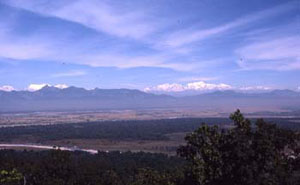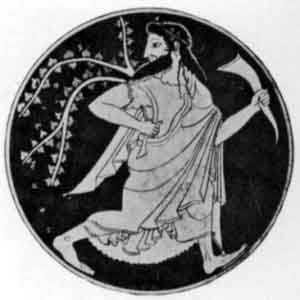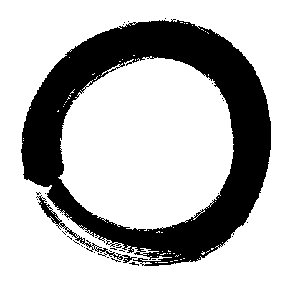
Red Cloud High School
Nature and Spirituality in the Himalayas: A Comparative Approach
| Home |
| Himalayan And Lakota Culture |
| Nature Literature |
| Comparative Mythology |
| Links |
| Bibliography |
| Biography |
Comparative Mythology
 Shiva-Cosmic Dancer
Shiva-Cosmic Dancer
I was an English/Classics double major at college and one of my interests is mythology, the ancient literature of imagination, creation, and wonder. I first started studying Greek and Roman myths and then moved to other world myths. I enjoy reading the work of Joseph Campbell, who takes a broad and wide-varying look at myths throughout the world.
"The first condition that any mythology must fulfill if it is to render life to modern lives is that of cleansing the doors of perception to the wonder, at once terrible and fascinating, of ourselves and of the universe of which we are the ears and eyes and the mind." ~ Joseph Campbell, Myth to Live by, pg. 256
Mythology often gives us insight into a world that is animate, alive, and magical. Myths teach us life lessons as well as how a culture views themselves and their world. Myths show us how a people connect to the land around them. On this page, I explore various cr0ss-cultural myths that are imbued with a sense of wonder and imagination. Myths often show how nature and spirituality are inextricably connected. Myths also often explain how a people view their country as specifically created by the gods, thus giving their country a numinous quality.
Himalayan Myth


Tibetan Myth
" Tibetan legends...tell us that Tibet was first covered by a vast inland sea. After its waters had receded, there appeared a monkey and an ogress who inhabited the rocky cliffs of Zotang near the modern town of Tsetang. The Tibetan people are descended from their union and are therefore endowed with the cunning of their ancestral father, but also with a touch of savagery due to their common, demonic mother. The story, which is first known only from post-tenth century Buddhist works, often adds that the monkey and ogress were in fact emanations of the bodhisattva Avalokiteshvara and the goddess Tara, thus predetermining the nation's adoption of the Buddhist religion, as well as the compassionate dispositions of the Tibetans themselves. ...
Alternative origin myths were also known. Very widespread, and often associated with the Bon religion, were cosmogonies that regarded the universe as having originated in a primordial egg, the gradual refinement of whose yolk gave rise to the world and its inhabitants. Though these have sometimes been interpreted as representing an indigenous Tibetan mythology, a resemblance to the widespread myth that in its Indian versions speaks of the cosmic egg Hiranyagarbha, the Golden Embryo, is unmistakable. It is conceivable, therefore, that what we find here is evidence of Tibet's close contact with West and South Asian civilizations, even apart from the later, well-known transmission to Tibet of Indian Buddhism." ~ Matthew T. Kapstein, The Tibetans, pgs. 33-34
Another look at Tibetan myth: http://www.crosby-lundin.com/tibet/culture/folktales/creation.html
Kathmandu Valley Myth
As described in Todd Lewis' Popular Buddhist Texts from Nepal, the origin of Kathmandu Valley is attributed to the compassion of the bodhisattva Manjusri, thus establishing the valley as a sacred place. This creation myth is described on the website: http://www.jyotirlinga.com/svayam.html
Here is an excerpt from that website which described the creation of Kathmandu Valley:
"The history of the Valley, according to the legends, begins with Swayambhu, or the "the self-existent". In times uncharted by history, Bodhisattva Manjusri came across a beautiful lake during his travel. He saw a lotus that emitted brilliant light at the lake's center, so he cut a gorge in a southern hill and drained the waters to worship the lotus. Men settled on the bed of the lake and called it the Kathmandu Valley. From then on, the hilltop of the Self-existent Lord has been a holy place. "
 Jataka Tales
Jataka Tales
Jatakas are rebirth narratives of the Buddha in his former lives. They are animal stories (much like Aesop's fables) that teach a particular message. These stories reveal the cause and effect of karma due to one's actions. As taught by Professor Todd Lewis, here is the standard structure of the jataka tale:
1. Frame narrative in the present of the Buddha's life
2. Story from a previous lifetime
3. Identification of the story characters with individuals in current life.
There is a wealth of source material on jataka tales on the internet. Here are some links to jataka tales if you are interested in reading some:
http://www.sacred-texts.com/bud/jt/index.htm
http://web.ukonline.co.uk/buddhism/jataka.htm
http://www.pitt.edu/~dash/jataka.html
http://www.buddhanet.net/bt_conts.htm
 Hindu Myth: Shiva
Hindu Myth: Shiva
Hindu myth presents a dazzling array of gods, goddesses, and monsters. One mythical figure I particularly like is Shiva the Destroyer, the Cosmic Dancer who brings energy and movement to the universe. It is the image of the world as the dance of the divine that I particularly like. Shiva is particularly revered in Nepal.
"Even the worshippers of Shiva-a violent and dangerous deity not easily credited with playfulness-explained the universe as formed in the gyrations of a cosmic dance in which, as Nataraja, or Lord of Dancers, Shiva, ecstatically creates and sustains and destroys." ~ Norvin Hein, "Lila" in The Gods at Play: Lila in South Asia, edited by William S, Sax, pg. 14
Websites on Shiva the Cosmic Dancer:
http://www.lotussculpture.com/nataraja1.htm
http://members.tripod.com/~Tetworld/siva.html
http://www.deeshaa.org/tandava-shivas-cosmic-dance/
http://www.coreymondello.com/nataraja.html
 Japanese Myth
Japanese Myth
The Japanese see their island country as created by the gods. Thus through myth the land is imbued with a sense of the sacred. Here is the creation myth of Japan according to Lewis Spense in his Introduction to Mythology:
" In the beginning, according to Japanese myth, heaven and earth were not separated and the In and Yo (the male and female principles) not divided. The Nihongi states that these male and female principles formed a chaotic mass like an egg which was of obscurely defined limits and contained germs. This egg quickened with life, the clearer part became Heaven, while the more ponderable portion settled down as the terrestrial sphere, like the floating of a fish sporting on the surface of the waters. An object like a reed-shoot appeared between Heaven and earth, and as suddenly became transformed into a god, Kuni-toko-tachi. Other divine beings were born, but those responsible for most of 'this sorry scheme of things entire' were Izanagi (Male who invites) and Izanami (Female who invites), concerning whom a very charming and original myth was told.
They stood on the floating bridge of Heaven and peered downward into the abyss below, asking each other what might exist so far below. Puzzled, yet determined to probe that mystery of nothingness beneath them, they thrust a jewel-spear downward, and touched the ocean. Drawing the spear upward, some water dripped from it, coagulated, and became an island, upon which the god and goddess set foot. Desiring each other as husband and wife, although they were brother and sister, they set up a pillar on the island, and by walking round it lost their relationship. Izanagi walked round one way and Izanami the other, exclaiming when they met: "Delightful! I have met with a lovely maiden," and "I have met with a lovely youth." They espoused each other, and Izanami gave birth to islands, seas, rivers, herbs, and trees, and having produced the Great-Eight-Island Country was desirous of bringing forth a living being who would be head of the Universe. In due season Ama-terasu, the sun-goddess, was born, and the moon-god, Tsuki-yumi. After the birth of the fire-god, however, Izanami suffered so greatly that she betook herself to the land of Yomi or Hades and was subsequently disowned by her husband." ~ Lewis Spense, Introduction to Mythology. pg. 168
More on Japanese Creation Myth:
http://www.crystalinks.com/japancreation.html
http://www.wsu.edu:8080/~wldciv/world_civ_reader/world_civ_reader_1/kojiki.html
http://www.yoga.com/ydc/enlighten/enlighten_document.asp?ID=201§ion=8&cat=168
 Greek Myth
Greek Myth
photo courtesy of http://www.gods-heros-myth.com/godpages/dionysus.html
Dionysus is a Greek god of ecstasy, wine, and fertility. Dionysus is connected both to nature and mystical spirituality. The best ancient text that features Dionysus is Euripides' play Bacchae.
"Dionysus represents the sap of life, the coursing of the blood through the veins, the throbbing excitement of nature; thus he is a god of ecstasy and mysticism." ~ Mark P. O. Morford and Robert J. Lenardon, Classical Mythology, pg. 190
Greek myth features a variety of tales that describe the natural world and its creation. Demeter is the goddess of grain and agriculture while Artemis is goddess of the woods and the hunt.
Celtic Myth
Celtic myth describes an animistic world of nature spirits. Important in Celtic mythology is the Tuatha de Danann, ancient kings and warriors. Celtic mythology inspired later writers who tried to revive this spirit, such as William Butler Yeats,
Celtic myth: http://www.lugodoc.demon.co.uk/MYTH/MYTH01.HTM
http://www.timelessmyths.com/celtic/index.htm
 Zen Koan
Zen Koan
Zen koan are stories and anecdotes used in Zen practice to break the shackles of the mind and its discursive logic. Although not mythological tales per se, I have included these stories for their unique and often startling perspective on the world. These stories are excerpted from Zen Flesh, Zen Bones, edited by Paul Reps and Nyogen Senzaki.
A Cup of Tea
Nan-in , a Japanese master during the Meiji era (1868-1912), received a university professor who came to inquire about Zen. Nan-in served tea. He poured his vistor's cup full, and then kept on pouring. The professor watched the overflow until he no longer could restrain himself. "It is overfull. No more will go in!" "Like this cup," Nan-in said, "you are full of your own opinions and speculations. How can I show you Zen unless you first empty your cup?" --pg. 19
Gutei's Finger
Gutei raised his finger whenever he was asked a question about Zen. A boy attendant began to imitate him in this way. When anyone asked the boy what his master had preached about, the boy would raise his finger.
Gutei heard about the boy's mischief. He seized him and cut off his finger. The boy cried and ran away. Gutei called and stopped him. When the boy turned his head to Gutei, Gutei raised up his own finger. In that instant the boy was enlightened.
When Gutei was about to pass from this world he gathered his monks around him. "I have attained my finger-Zen," he said, "from my teacher Tenryu, and in my whole life I could not exhaust it." Then he passed away.
Mumon's comment: Enlightenment, which Gutei and the boy attained, has nothing to do with a finger. If anyone clings to a finger, Tenryu will be so disappointed that he will annihilate Gutei, the boy, and the clinger altogether.--pgs. 119-120
Joshu Washes the Bowl
A monk told Joshu: "I have just entered the monastery. Please teach me."
Joshu asked: "Have you eaten your rice porridge?"
The monk replied: "I have eaten."
Joshu said: "then you had better wash your bowl."
At that moment the monk was enlightened.
Mumon's comment: Joshu is the man who opens his mouth and shows his heart. I doubt if this monk really saw Joshu's heart. I hope he did not mistake the bell for a pitcher.
Classroom Use:
1.Examine a myth and describe how the myth reveals a culture's perception of the natural world. Also, consider what the myth may teach the reader.
2 What is the function of myth?
Move on to Links